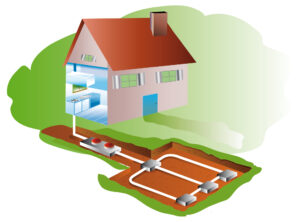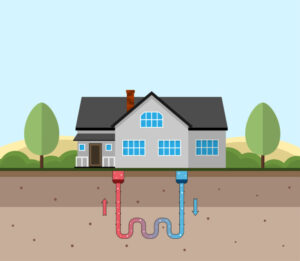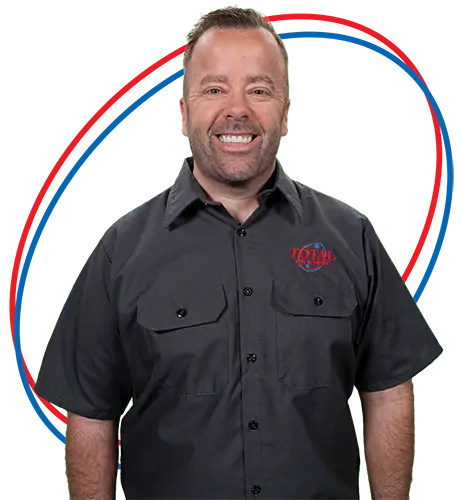Geothermal Heat Pumps: How Much Space Do You Really Need?
If you’ve been thinking about making the switch to a geothermal heat pump, you’re probably wondering about space requirements. It’s one of the first questions our customers ask us here at Total Air and Heat, and I totally get it you need to know if your property can actually accommodate this amazing technology before getting too excited about the energy savings.
What’s the Deal with Geothermal Heat Pumps Anyway?
Let me break it down for you. Geothermal heat pumps (or GHPs if you want to sound like an insider) work by tapping into the Earth’s constant underground temperature.
It’s pretty genius. During winter, they pull heat from the ground into your home. When summer rolls around, they do the reverse, pulling heat from your home and depositing it underground.
The best part? This approach is super efficient. My customers are always shocked when they see how much their utility bills drop after installation. Mother Nature provides free heating and cooling energy right beneath our feet we just need the right system to harness it!
How Much Space Do Different Systems Need?
Let’s talk about your options and what each one requires space-wise:
Horizontal Systems: The Land Lovers
If you’ve got a decent amount of yard space, horizontal systems might be your best bet. We typically dig trenches about 4 to 6 feet deep and lay pipes in loops.
Space needed: You’re looking at approximately 1,200 to 2,000 square feet of open land. Think of it as roughly the size of a small to medium-sized backyard.
These systems are generally more affordable to install than vertical systems but require more land. Many of my suburban customers opt for this approach when they have space.
Vertical Systems: Perfect for Tight Spots
Limited on space? No worries! Vertical systems might be your solution. Instead of spreading out, we drill down — typically 100 to 400 feet deep.
Space needed: Only about 500 to 1,000 square feet, which makes this perfect for urban properties or homes with smaller lots.
The downside? Drilling costs can add up, making vertical systems initially more expensive. But if space is at a premium, this extra cost might be worth it for the long-term energy savings.
Pond/Lake Systems: Water Wonders
Got a pond or lake on your property? Lucky you! Water-based systems use submerged coils to exchange heat with the water.
Space needed: You’ll need about 1,000 square feet of water surface area with adequate depth.
These systems are incredibly efficient and can be more affordable to install than vertical systems. I’ve had several customers with waterfront properties who’ve gone this route and couldn’t be happier with the results.
What Else Affects How Much Space You’ll Need?
It’s not just about the system type — several other factors come into play when determining your space requirements:
- Soil Type: Your soil matters! Sandy soils transfer heat better than clay or rocky soils. Better heat transfer means you might need less space (and fewer pipes) for the same heating/cooling capacity.
- Climate: If you’re in a region with extreme temperatures, your system might need to be larger to handle peak demand. Here in Texas, our summers can be brutal, so we make sure to account for that when designing systems.
- Your Home’s Size and Layout: Bigger homes need bigger systems — it’s as simple as that. We calculate your heating and cooling needs based on your home’s square footage, insulation quality, and other factors.
- Property Quirks: Got an oddly shaped lot? Existing landscaping you can’t bear to part with? Underground utilities? These can all affect where and how we install your system.
When Should You Call in the Pros?
I always tell folks that geothermal isn’t a DIY project (though I admire your ambition if that’s what you were thinking!).
Here’s when expert help is invaluable:
- Site Assessment: Every property is unique. We’ll evaluate your soil, available space, and existing structures to recommend the best approach.
- System Design: Getting the calculations right is crucial for efficiency. An undersized system won’t meet your needs, while an oversized one wastes money.
- Installation: Proper installation ensures optimal performance and system longevity. Our team at Total Air and Heat has been doing this for decades, so we’ve seen it all!
- Navigating Regulations: Permits, building codes, potential tax incentives — the paperwork alone can be overwhelming. We’ll guide you through it all.
Our Approach: From First Call to Final Comfort
At Total Air and Heat, we’ve been your next-door neighbor for 65 years, and we take pride in our thorough approach:
First, we’ll sit down with you to understand your home’s needs and assess your property. Then, we’ll design a system tailored to your specific situation. Our Eagle-Eyed Techs handle the installation with precision (and we clean up after ourselves, too!). Finally, we thoroughly test everything to ensure optimal performance.
The best part? We’re here for the long haul. Geothermal systems need maintenance, and we’ll be there to keep yours running smoothly for years to come.
Questions People Often Ask Me
How long will my geothermal system last?
The indoor components typically last 20-25 years (compared to 10-15 for conventional systems), while the ground loops can last 40-60 years. That’s some serious longevity!
Is geothermal right for my home?
If you have sufficient land or water access and plan to stay in your home long enough to recoup the investment (typically 5-10 years), geothermal can be an excellent choice.
What about maintenance?
Good news! Geothermal systems generally require less maintenance than traditional HVAC systems. Regular checks and filter changes will keep everything running smoothly.
Ready to Take the Next Step?
If you’re intrigued by the possibility of geothermal for your home, give us a call! We’re happy to assess your property and help you understand if this amazing technology is right for you. After all, at Total Air and Heat, we’re not comfortable until you are!

